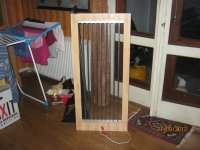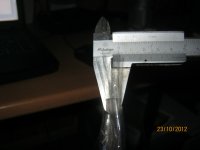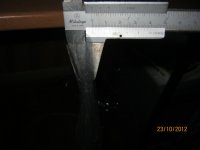can this material be used as a diaphram for my planar project? Black Chrome Automotive Films - Tinted automotive window film for cars, trucks - Black Chrome - 3M US . thanks for any advice in advance.
the best material to use is 12 um mylar c, that is what I use now, after trying rubbish bags and various different thick materials from 100 um down to 6 um. I have built and rebuilt over 60 planars using neos and ferrites. From A4 size up to 7' x 2'. I have hopefully finally reached my design goal.
Cellophan is used to wrap flowers, giftbaskets, cockies among other things.
Its a clear film that I taught was some sort of plastic initialy, but actually its made from cellulose!
It's more "brittle" compared to Mylar, but its easy to get hold of and cheap so for initial testing of principals - go for it!
If you want a stable long lasting speaker - get some Hostaphan or Mylar! 😉
/R
Its a clear film that I taught was some sort of plastic initialy, but actually its made from cellulose!
It's more "brittle" compared to Mylar, but its easy to get hold of and cheap so for initial testing of principals - go for it!
If you want a stable long lasting speaker - get some Hostaphan or Mylar! 😉
/R
You can use Monokote as well.
But use the thinnest stuff you can get.
I have used (Super) ultra kote as it was the thinnest I could find at about a little less than a 1mil.
It works great for a quick panel.
Although using a thicker material will get you a good tension it also raises the resonate frequency of the diaphragm.
This won't be to much of an issue on a large panel.
Once it is bonded to the frame you can also remove the glue layer by washing it with some acetone.
This won't do a whole lot but it does help to reduce the mass of the diaphragm for the higher frequency's.
But, Yes, .5mil to .25mil or so mylar is the best for high frequency's.
jer 🙂
But use the thinnest stuff you can get.
I have used (Super) ultra kote as it was the thinnest I could find at about a little less than a 1mil.
It works great for a quick panel.
Although using a thicker material will get you a good tension it also raises the resonate frequency of the diaphragm.
This won't be to much of an issue on a large panel.
Once it is bonded to the frame you can also remove the glue layer by washing it with some acetone.
This won't do a whole lot but it does help to reduce the mass of the diaphragm for the higher frequency's.
But, Yes, .5mil to .25mil or so mylar is the best for high frequency's.
jer 🙂
Try folding or stacking 10 layers of the film and then measure with the slide micrometer you have.
Divide measurement by 10 to get thickness of film.
Divide measurement by 10 to get thickness of film.
Geraldfryr messures in "
0.02mm is 20 my 20/1000
I dont recall what .5 mil is in 1/ooo mm.
Bernt
Ps.Thomas you got mail.
0.02mm is 20 my 20/1000
I dont recall what .5 mil is in 1/ooo mm.
Bernt
Ps.Thomas you got mail.
From your picture, looks to me that 10 layers of film measure 0.25mm thick.
So film thickness is 0.025mm = 0.00098", or ~1mil.
@båndsei
0.5mil = 0.0127mm = 12.7/1000mm
So film thickness is 0.025mm = 0.00098", or ~1mil.
@båndsei
0.5mil = 0.0127mm = 12.7/1000mm
Yes, My Micrometer is in Mil's 1/1000".
There is 25.4 microns per 1 mil as 1 um (micron) is 1/1000 of 1 mm .
1 micron=.0393700787 mil .
jer 🙂
There is 25.4 microns per 1 mil as 1 um (micron) is 1/1000 of 1 mm .
1 micron=.0393700787 mil .
jer 🙂
Mr. Bolserst : I must admit, it is 0,025 mm. !
1 mil ( What do you call the full name ?) = 0,0254 mm.
Thomas.
1 mil ( What do you call the full name ?) = 0,0254 mm.
Thomas.
A "mil" is the same as a "thou." Both refer to a thousandth and are nicknames for 0.001 inch. I really wish President Thomas Jefferson had gotten his way over 200 years ago so the US could now use the same system of units as the rest of the world.
Because there are, by definition, 25.4 mm in one inch, there are exactly 25.4 microns (micrometers) in each thousandth of an inch (mil or thou).
Now for tablespoons, cups, board-feet, fluid ounces versus ounces of weight, and yards (as a measure of volume!)... It's a marvel anyone can make anything with this system.
Few
Because there are, by definition, 25.4 mm in one inch, there are exactly 25.4 microns (micrometers) in each thousandth of an inch (mil or thou).
Now for tablespoons, cups, board-feet, fluid ounces versus ounces of weight, and yards (as a measure of volume!)... It's a marvel anyone can make anything with this system.
Few
that depends upon which inch you are referring to. there are a number of different inches, just to make things more difficult. Then we have people using the term mil to refer to mm so yes it can get confusing. Best regards Moray James.
- Status
- Not open for further replies.
- Home
- Loudspeakers
- Planars & Exotics
- diy planar speaker diaphram question



